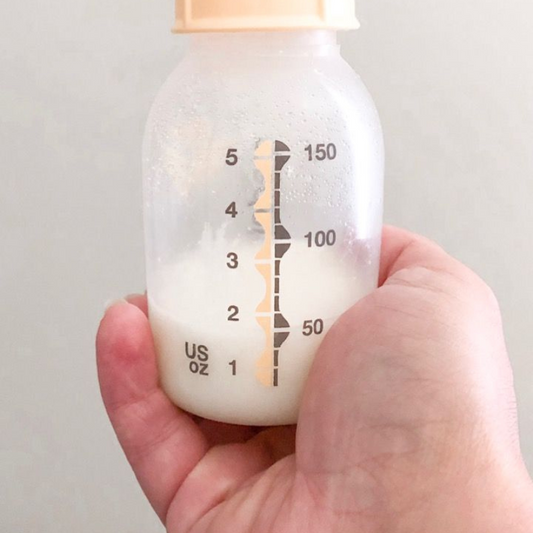Many mamas think their milk supply is dropping, without understanding the true signs of a low, or decreasing milk supply. Most importantly, there needs to be enough milk to meet baby's needs, and also increase baby's weight from their birth weight. The most basic sign of making enough milk in the early weeks is the fact that baby is gaining weight. Breast milk supply is considered sufficient if baby is gaining weight after they may lose some weight in the early days. After having 4 babies myself, I know I could tell there was enough milk for baby when my milk came in, and baby would drink and drink until they fell asleep. That was my own personal sign that baby was getting as much milk as they needed in one feeding. Your healthcare provider will check baby a few days after birth to see if any nomral weight loss is corrected, and they start gaining weight. If you think you aren't making enough milk, and your milk supply has come in, there are signs you can look for that mean your supply is low, and there are also false signs, which may lead new mommies to believe they aren't producing enough milk, and then there are true signs that your breast milk quantity is dwindling.
What are some false signs of a low milk supply?
Here are some signs that can lead a breastfeeding mother to believe her milk supply is dropping, but are actually perfectly normal.
- An empty/deflated and softer breasts
- Baby wanting more feedings (cluster feeding)
- Baby waking to feed at night
- Short feeds
- Fussy feeds (baby seems dissatisfied)
- Pumping less after a feeding
- Baby wanting a bottle even after breast feeding
- Fussy baby in the evening
- No feeling of a let down
Many of these are perfectly normal phases of breastfeeding a new born. Babies often want to nurse more for comfort, they may be going through a growth spurt, have tummy issues (very normal for new babies), or like to have a bottle after breastfeeding out of habit. These experiences do not mean your milk supply is dropping, or you aren't producing enough milk supply. There are only a few ways to really tell if you have a low milk supply.
The true signs your milk supply is low, or decreasing:
Baby isn't gaining enough weight:
Poor weight gain is one of the biggest signs you may not be producing enough milk, or your supply has decreased. Many babies lose weight right after birth, as it takes time for colostrum and milk to kick in. The early weight loss is normal, but your pediatrician will be able to tell you when your baby should be gaining weight, and how much they should be gaining. It is really important that if you think your baby isn't gaining enough weight, to check with your pediatrician and set some weight goals for follow ups. There are some great tips at the end of this post to help you encourage your body to produce more milk if you really are experiencing a low milk supply, and this has been confirmed by your pediatrician. The best way to know if the amount of milk you are producing for baby isn't enough is by baby's weight. Many mamas want to look at the amount of ounces they pump, but that doesn't always translate to the amount that baby is actually drinking. If you are struggling to pump enough milk, that doesn't mean you have a low supply, but rather you are looking to increase your supply to go beyond what baby needs, so you can store extra milk for future use. Breastmilk supply is usually just right for baby, but many moms need extra milk to save for going back to work! If that is your case, keep reading for tips to increase your supply beyond what baby needs, so you can develop a large freezer stash.
Pumping ounces doesn't always correlate to your breastmilk production:
A true low milk supply is when you can't produce enough breast milk for baby to gain weight. If you use a breast pump to monitor your milk supply, you may be confused when the ounces you pump aren't much at all. Many mamas, when their baby has a good latch, no tongue tie, and great weight gain, think that if they pump only a few ounces they have a low milk supply. If you are struggling to pump extra milk, that doesn't mean you have a low milk supply. The good news is that you are making enough breastmilk for baby, but your body needs encouragement and support to produce extra milk in between baby's feedings.
also read: How To Deal With A Sudden Drop In Milk Supply
Baby doesn't have enough soiled/wet diapers:
This is another sign of a low milk supply, that you can see at home. Babies who eat a lot also have a lot of stinky diapers. This can be a bit more confusing than the weight-gain sign because it is also normal for some babies to go longer between dirty diapers as their digestive system matures. In the first week, there may be days between soiled diapers as baby's digestive system is adjusting to the breast milk production. Overall, dirty diapers and blow outs are a healthy sign your baby is getting lots to eat. If you have any underlying intuition that your baby doesn't have enough dirty diapers, and seems to be gaining weight very slowly, or not at all, check with your pediatrician right away.
These are the two major signs of low milk supply, that can actually be monitored and quantified. It may seem too simple with only two major signs, but it should also leave some peace of mind. Let's get into some quick and easy ways you can increase your milk supply quickly, to help satisfy baby.
Reasons you may really have a low milk supply and how to fix it:
Low milk supply can be caused by a variety of factors, and it's essential to understand that many breastfeeding mothers can overcome these challenges with the right support and strategies. Here are some common reasons for low milk supply:
-
Inadequate Breast Stimulation: Frequent and effective breastfeeding or pumping is necessary to establish and maintain milk supply. Inadequate stimulation, such as infrequent feedings or short nursing sessions, can lead to a decrease in supply.
-
Latch Issues: An improper latch can hinder milk transfer and reduce milk supply. Babies who have difficulty latching properly may not be able to extract milk efficiently.
-
Medical Condition: Certain medical conditions can affect milk production. Conditions like polycystic ovary syndrome (PCOS), thyroid disorders, diabetes, and hormonal imbalances may contribute to low milk supply. As your health care provider to check for these conditions if you think they are a cause of less milk.
-
Premature Birth: Premature infants might initially have difficulty breastfeeding effectively due to underdeveloped sucking reflexes. However, many preemies can eventually breastfeed successfully with proper support.
-
Maternal Stress and Fatigue: High stress levels and exhaustion can impact milk supply negatively. It's essential for breastfeeding mothers to get enough rest and manage stress as much as possible.
-
Supplementing with Formula: Using formula supplements can lead to a reduced demand on the breast, causing milk supply to decrease. If supplementation is necessary, it should be done under the guidance of a healthcare provider or lactation consultant.
-
Scheduled Feedings: Feeding a baby on a strict schedule rather than on demand can reduce milk supply. Babies should be allowed to nurse when they show hunger cues.
-
Medications: Some medications, including certain contraceptives, decongestants, and antihistamines, can affect milk supply. It's important to consult a healthcare provider before taking any medication while breastfeeding.
-
Breast Surgery or Injury: Previous breast surgery or injury, especially if it involves the removal of milk-producing tissue, can impact milk supply.
-
Hormonal Birth Control: Some hormonal birth control methods can interfere with milk supply. Discuss contraceptive options with your healthcare provider if you're breastfeeding.
-
Insufficient Glandular Tissue: Some women have insufficient glandular tissue in their breasts, which can limit milk production.
-
Infections and Illness: Infections, such as mastitis, can temporarily reduce milk supply. Addressing these issues promptly and continuing to breastfeed is usually recommended.
-
Weaning: Gradual or abrupt weaning can lead to a decrease in milk supply. It's best to wean slowly if you want to maintain some level of breastfeeding.
Quick and easy ways to increase milk supply fast:
There is a lot of information out there on ways to increase your milk supply. These are the methods that have been proven to work, and confirmed by science, studies and professionals (lactation consultants, nurses and doulas).
Make sure to read: How Milk Dust Safely Promotes Weight Loss While Breastfeeding
Add in Galactagogues:
Galactagogues are herbs and foods used to increase milk supply. There is a lot of anecdotal studies proving various herbs to be helpful for milk supply, as well as centuries of Eastern medicine using these herbs for lactation support that give us reason to believe specific herbs are very helpful for milk supply. Our lactation blend in Milk Dust, is based of real research and science backing specific combinations of herbs for the best result. Fenugreek has shown some side effects in new mothers, mainly because it is given in high-doses solely as the one herb to increase supply. Of course in higher doses, and more popularity is going to bring more side effects. We have an in-depth post on the studies proving fenugreek as a powerful herb for milk supply, particularly when combined with other galactagogues like feenel, milk thistle, red raspberry leaf, tumeric and brewer's yeast. Studies show that combining these herbs, rather than high doses of one herb, seem to produce the best results in increasing milk supply.
Try Milk Dust Lactation Protein Powder:
Milk Dust offers a unique, science-backed lactation blend of powerful galactagogues to increase milk supply fast.
The Milk Dust lactation blend consists of these specific ingredients that increase milk supply:
Milk thistle:
Milk thistle is widely used as a galactagogue, and there is a great study that reports a 32% increase in milk supply after mothers used it for 63 days. "Results:Women orally treated for 63 days with Silymarin showed a clear galactagogue role for the product with an increase of 85.94% of the daily milk production (placebo: +32.09%). No drop out, nor unwanted effects were reported in both groups. Compliance and tolerability were also very good…" This is great news, and shows the power of milk thistle for lactation. This is one of the main ingredients in the lactation blend.
Organic Red Raspberry Leaf:
Red raspberry leaf doesn't have as much clinical backing on its own for milk supply specifically, but it is amazing in supporting overall hormonal health in women. In addition. red raspberry leaf when combined with other ingredients like fenugreek are shown to increase milk supply in this study. In addition to the lactation benefits, Vitamin B6, found in red raspberry leaves, is a fighter of all things PMS, including mood changes and irritability. In addition, B6 binds to estrogen, progesterone, and testosterone, helping regulate these steroid hormones, reducing your risk of cancer. Lactation is a very hormonal-dependent process, so any ingredient that helps balance this process is going to benefit lactation.
Brewer's Yeast:
Brewer's yeast is one of the ingredients that has been used for centuries to increase lactation. This means that there are hundreds of years of anecdotal evidence to support its use. The studies illustrate that it is actually the nutritional enhancement brewer's yeast provides that increases milk supply. This is where Milk Dust differs than other lactation drinks, which I will go into, but Milk Dust also targets nutrients that help increase and support lactation as well. This study states, "Although studies in ruminants indicate that brewer's yeast might increase milk supply, the effect is attributed to improved nutrition (increases in vitamin B and chromium) rather than any specific effect on lactation." Overall, with the centuries of use and amazing nutrient qualities, it is an important part of the Milk Dust lactation protein blend.
Fenugreek seed:
Fenugreek has both anecdotal and evidence-based studies. This means that subjects reported an increase in milk supply based on their own experience when using fenugreek to increase milk supply. "In a US survey, of 122 mothers who used fenugreek as a galactogogue 43% thought it increased milk supply and 5% thought it decreased their milk supply" (study). In addition, fenugreek was included in an overall study of various herbs to increase lactation. "Shatavari, torbangun, fenugreek, milk thistle, and a Japanese herbal medication were the 5 herbal preparations studied. Five trials found an increase in breast milk production. "(study). My favorite study is this one, that shows fenugreek alone increased milk supply against a placebo. Any studies using a placebo are very helpful becuase the comparison shows the power of the product itself. "The NMA results of 4 studies indicated that consumption of fenugreek significantly increased amount of the produced breast milk [11.11, CI 95% 6.77, 15.46] versus placebo. " This is 4 studies, which shows the power of fenugreek alone, and why it is an essential part of the Milk Dust lactation blend.
Fennel seed:
Fennel seed is very similar to fenugreek, and it too has been shown to increase milk supply both anecdotally and in scientific studies. The International Journal of Pediatrics reports that, "Ten studies were included into review. Five studies showed the fennel alone or in herbal tea can increase breast milk and neonatal anthropometry." 10 studies is a lot, and those studies focused on fennel, showing the power of the ingredient by itself to increase lactation.
THE POWER OF THE MILK DUST LACTATION BLEND:
By blending all of these ingredients together, you can harness the power of each of them in slightly smaller doses. This helps mitigate any of the possible side effects, and allows all of them to work together. This is why Milk Dust is so successful in increasing milk supply. It offers the best, most researched ingredients in one blend to really support healthy lactation. Lactation consultants use this, and Milk Dust has been used to help mothers relactate!
"I am constantly looking for supplements and tools to help my ladies. I ordered your sample pack and tested it for 6 days. I can honestly tell you I loved it, I was really impressed with the smell and taste, your lactation blend is great, the product overall exceed my expectations."
- Michele Hodges Lactation Consultant + Lactation Sation Podcast
Eat nutrient-dense foods:
Depending on your current diet, you may need to add in more nutrient-dense foods, so your body has more nutrients to give to baby. Eating the right foods, rather than enough calories is something many mothers aren't educated on after birth. Women's bodies are designed to used stored fat and nutrients in the diet to produce breast milk. If there is a lack of quality, lactation-supporting foods like vegetables, fruits, lean proteins, good fats and high-quality carbs like quinoa and oatmeal, then your body may signal this with a lack of production. Protein smoothies made with Milk Dust are a powerful combination of real foods and nutrients, combined with superfoods in Milk Dust like chlorella, spirulina and spinach, galactagogues and other essential vitamins and minerals postpartum mothers need is a great way to infuse your body with the building blocks of a healthy milk supply.
The Boob Food Nutrition Master Course To Increase Supply
The Meaning Behind Sugar Cravings While Breastfeeding
Add in more feedings + skin to skin:
This is one of the fastest ways to increase your milk supply because your body creates milk based on demand. If you have baby demand more, your body will be encouraged to make more. Keeping a lot of skin-to-skin contact throughout the day and during feedings will keep the pheromones working properly to signal the hormone levels and Oxytocin production needed for lactation. Try wearing baby as much as possible and letting baby sleep on your chest to encourage the chemical connection.
Massage your breasts while feeding:
You can help your baby express more milk by adding in some massage and compression during feedings. This will encourage your breasts to express more milk, then want to replenish that milk by creating more. Baby might get large gulps at first, with some needed burping after, but it will help get more milk out during feeds.
Pump one side, while baby feeds the other:
Many mamas with a low milk supply despise pumping because the amount is so little and depressing. By pumping one side while baby is feeding the other, you are taking advantage of baby's natural ability to stimulate your let down better than a machine. By emptying one breast, you can use baby on the emptied breast to encourage more milk. At the next feeding, switch the side you pump. Always have baby feed on the side that already pumped. This is a really helpful way to get more milk stored, while also encouraging more milk volume. It will take a lot of the hard work of pumping out of the situation, and babies have an incredibly ability to get your body to product more milk, better than a machine can.
If you are experiencing these signs of low milk supply, these tricks will really help.
Many mamas have had success using our protein powder because it is so much more than a milk-boosting protein powder. It nourishes postpartum mothers properly, to help nourish baby, reduce sugar cravings and aid in weight loss. If you are struggling with eating healthy, getting in the nourishment you need and milk supply, Milk Dust is here to help!



